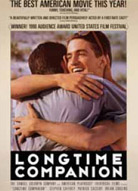The email sent will contain a link to this article, the article title, and an article excerpt (if available). For security reasons, your IP address will also be included in the sent email.
Team Experience is looking back on past Sundance winners since we aren't attending this year. Here's Kyle Turner on an LGBT indie that took the Audience Award and proved so popular in release that it even snagged a Best Supporting Actor nomination (Bruce Davison) at the Oscars a year later.
 an early scene in Longtime Companion
an early scene in Longtime Companion
In the first fifteen minutes of Longtime Companion, the words “Did you see the article?” fall from around a dozen different characters’ mouths. It’s July 1981, when the New York Times published its piece titled “Rare Cancer Seen in 41 Homosexuals”, and the way news gets around is by press and by word of mouth. These characters, all gay men in their 20s and 30s, shrug it off, try to carry on with their lives.
 To them, this cancer is nebulous, unworthy of their time, and yet something that occupies their thoughts all the same. Thus, the film exists within a particular time, where information is dispersed differently, yet dismissed similarly.
To them, this cancer is nebulous, unworthy of their time, and yet something that occupies their thoughts all the same. Thus, the film exists within a particular time, where information is dispersed differently, yet dismissed similarly.



 Return to Article
Return to Article